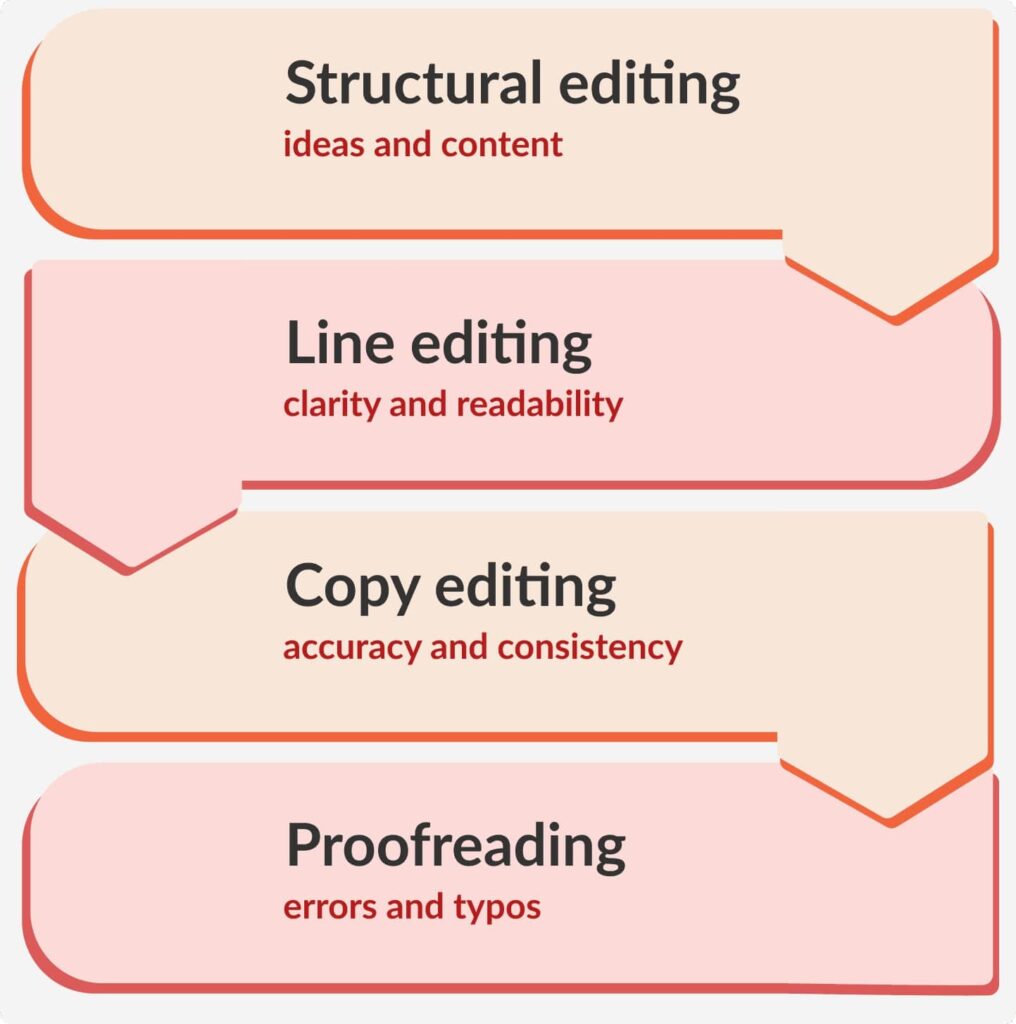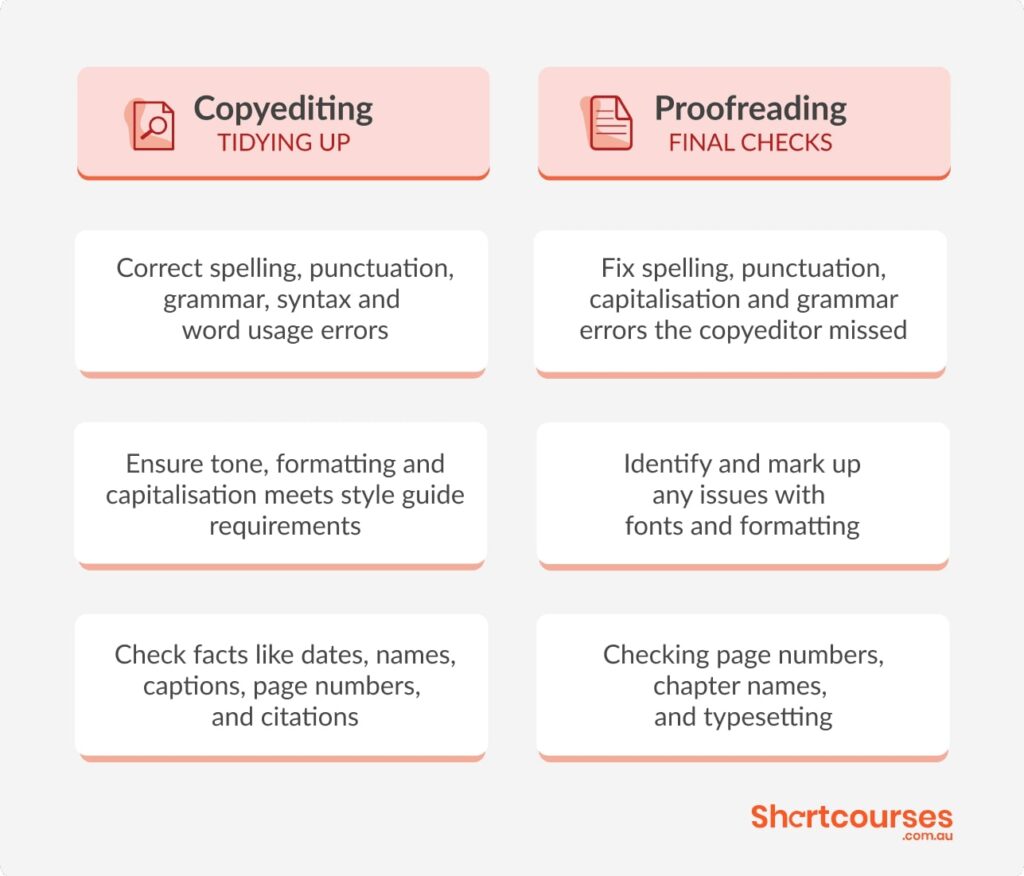How to Become a Proofreader in Australia

Can you spot a misplaced apostrophe from across a football field? Do incorrect homonyms make your eye twitch?
Then chances are you’d be an excellent proofreader. This flexible job is great for people who love reading — whether you’re looking for full-time work, a part-time job or a freelance gig.
Read on for practical steps and relevant information you need to start as a professional proofreader.
What is a proofreader?
Proofreaders check writing to ensure it is error-free before submission or publication. They read through a text, identifying and correcting spelling mistakes, typos, punctuation or grammatical errors. In publishing, they also check that page proofs adhere to design specifications.
Professional proofreaders mostly (77%) work part-time, in places like publishing companies, newspapers, websites, and government agencies.
On the other hand, freelance proofreaders can choose their hours. They can work for all different clients, sometimes working directly for an author. Many proofreaders specialise in particular niches, like academic papers or business reports.
Proofreaders vs copyeditors
They’re often mixed up, but proofreading and copyediting are two stages of the editing process.
Proofreading comes after copyediting, right at the end of the editing process.


If you think of publishing as creating pieces of furniture, here’s how you’d break down the roles:
- Copy editor: The copyeditor puts the finishing touches on the varnish and smoothes out any rough edges.
- Proofreader: The proofreader does a quality assurance check on each piece before it leaves the warehouse.
Back in the days of typesetting and printing, the copyeditor did the last edit before they sent a text to the typesetter, who would create a ‘proof’ (test print).
The proofreader would take a final pass over the proof and mark up any errors. The aim was to pick up anything missed in the copyediting stage, like typos and formatting issues, so the typesetter could make any final corrections or adjustments before printing thousands of copies.
With digital printing and publishing, the boundaries between the two have blurred somewhat. Many freelance proofreaders work directly with writers, and proofs are usually digital rather than on printed paper. For this reason, many freelance proofreaders also offer a light copyedit as part of their service.
But strictly speaking, a proofreader is the last person who looks at a piece of text before it’s submitted, sent to a printer, or published online.
How to become a proofreader in Australia
While you generally don’t need a degree to become a proofreader, most hiring managers will want their employees to have a bachelor’s degree in English, journalism or communications.
These degrees can take up to four years to complete and will teach you all you need to know about non-fiction and creative writing as a whole, with editing subjects built-in. But that’s not the only way to get proofreading training.
Is there a course for proofreading?
There are plenty of proofreading courses you can enrol in. These online courses can be helpful to get you started and build your confidence. You’ll learn to approach your work effectively, fill knowledge gaps and master the most up-to-date grammar rules.
Already got a degree in something related? Taking a short course can show potential clients and employers you’re interested. Typically short courses, you can complete them alongside work, caring or study responsibilities.
On the other hand, you might prefer to do your own research. Some practice proofreading exercises to get you started:
Books are a great place to start your self-study, and you might want to try one of these:
- Eats, Shoots & Leaves: The Zero Tolerance Approach to Punctuation by Lynne Truss
- The Sense of Style: The Thinking Person’s Guide to Writing in the 21st Century by Steven Pinker
- Dreyer’s English: An Utterly Correct Guide to Clarity and Style by Benjamin Dreyer
There’s also the option of online language courses that can teach you the proper usage of grammar, spelling and punctuation and hones in on your writing skills.
Accreditation and professional associations
Once you’ve been a proofreader for two years or more, you can take a test to get accredited with Australia’s professional editor’s association, the Institute of Professional Editors Limited (IPEd). Accreditation isn’t necessary, and it will cost you around $900, but it does indicate that your work is of high quality and will put you in their directory of editors.
Another professional association you could consider joining is the Media Entertainment and Arts Alliance (MEAA).
How much do proofreaders get paid?
Proofreaders earn an average of $35/hr in Australia.
Though most work part-time, the median annual full-time salary for proofreaders is $71,916, according to JobOutlook.
Proofreading skills
Accreditations and degrees can undoubtedly help ensure your skills are up to scratch, but you live by your knowledge and tools as a proofreader. The most important thing to have is an excellent grasp of English, including:
- The oxford comma
- Spelling and grammar
- Commonly misspelled words
- Punctuation mistakes
- How to punctuate dialogue and quotes
- Homonyms and homophones
- Capitalisation
- Verb tenses
- Hyphenation

You’ll also need knowledge of writing conventions and standard formatting. That’s where these style guides come in handy:
- Associated Press Style (AP Style)Typically used in the journalism industry.
- Style ManualUsed for creating Australian government content.
Since many proofs will come to you in PDF or Indesign formats, employers will also want you to be familiar with the various professional editing programs, such as Adobe Acrobat and InDesign.
General tools you will need:
- Computer
- Internet connection
- Google docs, or Microsoft word
- PDF software for converting documents to PDFs
- Proofreading software (like Hemingway, Grammarly, or ProWritingAid)
- Accounting software for invoicing clients
How to find proofreading jobs
If you decide you’d like to work full-time or part-time, you can become an in-house proofreader.
At a publishing house, you can work on books and manuscripts, while at a smaller company, you can specialise in technical, academic or scientific writing.
Remote work is also popular in the proofreading community, making it a fantastic flexible job. You can try out for a job at a proofreading company to get an influx of regular assignments. Here are some great places to start:
Become a freelance proofreader
Interested in a side gig or extra income? Or maybe working from home is more your speed. Being a freelance proofreader gives you more control over the hours you work and the amount of work you take on. You’ll also have the chance to work on various writing projects.
Many authors and writers seek out proofreaders online. The dramatic increase in demand for online content is also driving demand for freelance writers and editors — excellent news for aspiring proofreaders, too.
Here’s how to get started as a freelancer:
- 1. Make it easy for people to find you. When someone needs a proofreader, you want to make sure they know you’re up for the job. Set up a website, create social media profiles, and post about your services on LinkedIn.
- 2. Get registered. Before you start taking on freelance work, you’ll need to get an Australian Business Number (ABN).
- 3. Learn to run a business. Since being a freelancer means managing everything yourself, it can also be a great idea to take a short small business course.
- 4. Find a niche. More often than not, getting jobs as a freelance proofreader is as simple as looking them up online and applying for them — although applying to every single proofreader position is not exactly the best course of action. Most people want someone who is familiar and has a deep understanding of a particular area of writing. Not to mention, by narrowing down what you proofread, you’ll know what to look for and become an expert.
- 5. Make it easy for people to find you. When someone needs a proofreader, you want to make sure they know you’re up for the job. Set up a website, create social media profiles, and post about your services on LinkedIn.
Some freelancers offer additional services, like copyediting, proofreading in multiple languages, transcribing or indexing. You may want to think about expanding your offering to offer more value to your clients.
When you’re starting out, you can get your first gigs on freelance websites. This helps you get to grips with the trade and start building a network of clients.
Here are some freelance marketplaces to consider signing up to:
- Clickworker
- Fiverr
- Get Editing Jobs
- Upwork
- MediaBistro
- FlexJobs
- Lionbridge
- Proofreading Pal
- Reedsy
- OneSpace Freelancers
- EditFast
- Guru
- Writing Jobz
- Writer’s Job Shop
- Domainite
- Wordvice
There are a few steps involved in becoming a successful proofreader, and it won’t happen overnight. But if you stick with it, learn the trade, and put the word out there, proofreading is rewarding work that gives you plenty of freedom and flexibility.